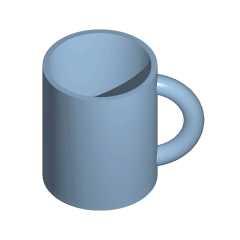 | ||
In the mathematical field of topology, a homeomorphism or topological isomorphism or bi continuous function is a continuous function between topological spaces that has a continuous inverse function. Homeomorphisms are the isomorphisms in the category of topological spaces—that is, they are the mappings that preserve all the topological properties of a given space. Two spaces with a homeomorphism between them are called homeomorphic, and from a topological viewpoint they are the same. The word homeomorphism comes from the Greek words ὅμοιος (homoios) = similar and μορφή (morphē) = shape, form.
Contents
Roughly speaking, a topological space is a geometric object, and the homeomorphism is a continuous stretching and bending of the object into a new shape. Thus, a square and a circle are homeomorphic to each other, but a sphere and a torus are not. An often-repeated mathematical joke is that topologists can't tell the difference between a coffee cup and a donut, since a sufficiently pliable donut could be reshaped to the form of a coffee cup by creating a dimple and progressively enlarging it, while preserving the donut hole in a cup's handle.
Definition
A function f: X → Y between two topological spaces (X, TX) and (Y, TY) is called a homeomorphism if it has the following properties:
A function with these three properties is sometimes called bicontinuous. If such a function exists, we say X and Y are homeomorphic. A self-homeomorphism is a homeomorphism of a topological space and itself. The homeomorphisms form an equivalence relation on the class of all topological spaces. The resulting equivalence classes are called homeomorphism classes.
Examples
Non-examples
Properties
Informal discussion
The intuitive criterion of stretching, bending, cutting and gluing back together takes a certain amount of practice to apply correctly—it may not be obvious from the description above that deforming a line segment to a point is impermissible, for instance. It is thus important to realize that it is the formal definition given above that counts.
This characterization of a homeomorphism often leads to a confusion with the concept of homotopy, which is actually defined as a continuous deformation, but from one function to another, rather than one space to another. In the case of a homeomorphism, envisioning a continuous deformation is a mental tool for keeping track of which points on space X correspond to which points on Y—one just follows them as X deforms. In the case of homotopy, the continuous deformation from one map to the other is of the essence, and it is also less restrictive, since none of the maps involved need to be one-to-one or onto. Homotopy does lead to a relation on spaces: homotopy equivalence.
There is a name for the kind of deformation involved in visualizing a homeomorphism. It is (except when cutting and regluing are required) an isotopy between the identity map on X and the homeomorphism from X to Y.
